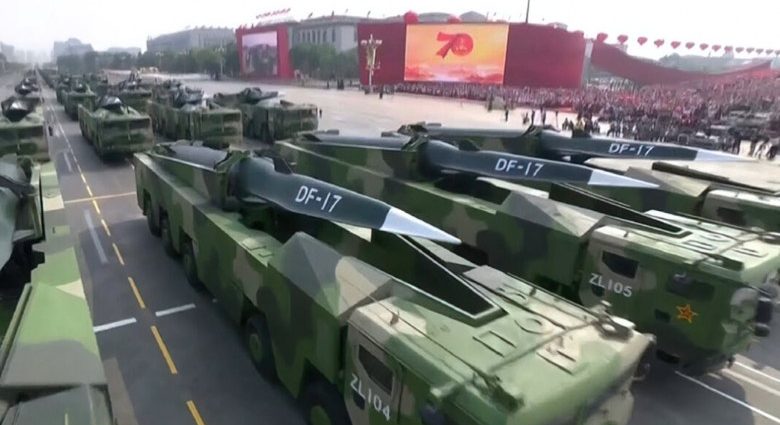The US aims to leverage private sector investments in commercial hypersonic vehicle technology to build a high-speed test aircraft, marking Washington’s latest bid to bring its hypersonic weapons program up to speed vis-à-vis rivals China and Russia.
This month, the US Defense Innovation Unit (DIU) posted a notice for its Hypersonic and High-Cadence Airborne Testing Capabilities (HyCAT) project seeking commercial proposals for new hypersonic vehicles to support its high-cadence testing and evaluation of new and emerging hypersonic technologies.
The DIU notice says that current US hypersonic land and sea-based test ranges are designed for low-cadence and operationally-representative tests that duplicate the performance of hypersonic weapons. It also mentions that the slow pace of US-based hypersonic weapons research and development has resulted in more expensive and less effective products.
Defense website C4ISRNET reports that US testing infrastructure has significantly impeded hypersonic weapons development, with most significant programs conducting only a few tests yearly.
However, in a September 1 interview for C4ISRNET, Barry Kirkendall, DIU’s technical director for space, mentioned a test a week as the ideal testing cadence. In addition, he said that HyCAT aims to clear some of the log jams that have impeded the hypersonic weapons testing program over the past decade.
C4ISTRNET mentions that the HyCAT project works in partnership with the Pentagon’s Joint Hypersonics Transition Office and the Undersecretary of Defense for Research and Engineering’s principal director for hypersonics, Mike White.
Moreover, Kirkendall mentions that the Pentagon’s office approached DIU this March, a month after senior US officials met with hypersonic industry executives to discuss the roadblocks in the US’ laggard hypersonic weapons program.
Asia Times reported this high-profile February meeting was convened by US Secretary of Defense Lloyd Austin with CEOs of leading US defense companies to gather feedback about the impediments hampering US hypersonic weapons development.

The CEOs mentioned several challenges in the US hypersonic weapons program, namely supply chain constraints, acquisition barriers, budget instability and poor access to test facilities. They also noted that the US Department of Defense (DOD) would struggle with a “test often, fail fast and learn” approach without suitable testing facilities.
US hypersonic test failures can be attributed to overly complicated weapons design, rushed testing, poor project management and trivializing costly failures, according to news reports.
As such, the US is years behind China and Russia’s hypersonic weapons programs, with the technology deployed in its crash course program to field working prototypes, expected to take several years to mature.
Despite these clear lapses and shortfalls, Kirkendall claims that the DIU has achieved good results with investor money, with HyCAT addressing the DOD’s hypersonic testing issues and strengthening its relationship with the commercial sector. He also notes that the DIU expects hypersonic-related investors from Japan, Australia, Norway and India.
Australia, in particular, may give the US’ struggling hypersonic weapons program a much-needed technological boost. In March, Australian private firm Hypersonix introduced US officials to a new type of hypersonic scramjet engine that it claims has several advantages over US designs and could be 3D printed in three weeks, Asia Times reported.
However, Hypersonix claims that the high-temperature composites needed for its engine are unavailable in Australia and stressed the urgent need to develop and produce them in-country.
India may also partner with the US HyCAT program to help develop its hypersonic weapons. Asia Times has reported that US sanctions against Russia’s NPO Mashinostroyeniya could derail the development of India’s Brahmos II hypersonic missile, a joint project with Russia.
Wary of this possibility, India is pursuing other hypersonic weapons projects researched and funded separately from Brahmos II.
Significantly, the DIU’s HyCAT project tender comes amid signs that US officials are in denial about America’s hypersonic weapons gap with China and Russia.
Despite successive US test failures, the US claims that viewing its laggard hypersonic weapons development as a tit-for-tat arms race with China and Russia is misleading.

US arguments against this view include its development of counter-hypersonic defenses, the unclear effect of hypersonic weapons on overall strategic nuclear deterrence and the lack of a precise hypersonic doctrinal application in US service.
Despite official US denials of a hypersonic arms race, the US may be coming around to the weapons’ deterrent value.
Lieutenant General Steven Rudder, commanding general of US Marine Corps Forces, Pacific (MARFORPAC), has noted that long-range strike capabilities embodied in hypersonics are critical for the US and Japan to deter China in the Pacific, as pointed out in a Nikkei article this month.
The article notes that the US is in talks with Japan to deploy an anti-ship unit in 2027, with the US establishing Marine Littoral Regiments that include anti-ship missile units.
In this connection, Asia Times has reported on the US Marine Corps OpFires land-based hypersonic missile system, which it successfully tested this July.
OpFires can complement the US and allied air and naval power by ensuring a near-constant presence in contested areas and providing operational and tactical cover to ensure freedom of maneuver for naval and air operations.

